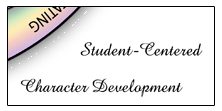This version of the electronic Faculty Guidebook is
more interactive than ever before. This page offers a sample of each of
the different types of interaction so that you can make sure your browser
and computer will support the interactivity.
| Type | Try it... | Do this... | What SHOULD happen... | ||||||||||||||||||||||||||||||||||||
| Bio-sketch Links |
Carol Holmes
(Consultant for Faculty Development, Pacific Crest) |
Click the bold text (Carol Holmes). |
A new window should open which shows biographical information. Simply close this new window when you are finished with it. |
||||||||||||||||||||||||||||||||||||
| Glossary Links | Assessment is the process that supports learning improvement and links it to growth. | Simply HOVER your cursor/mouse over the text in magenta to view the definition of that term or phrase. | A box with the glossary definition of the term should appear. To close the definition window, either use the close button in the window, click elsewhere on the page, or simply wait several seconds. | ||||||||||||||||||||||||||||||||||||
| Module Links | 2.5.1 Boyer’s Model of Scholarship | Click the module name. |
Clicking a module link will open that module in the current window. To return to the original module, simply use your browser's back button. |
||||||||||||||||||||||||||||||||||||
| Intramodule Links | Table 1 | Click the text. | The page should 'jump' to the table. You can return to your previous position by using the <back> button in your browser. | ||||||||||||||||||||||||||||||||||||
| External Links |
American Association of Colleges and Universities. <http://www.aacu.org> |
Click the hyperlink (the http stuff). | Clicking on these links will open that website in a NEW browser window. | ||||||||||||||||||||||||||||||||||||
|
Pop-up Window in an Image Map |
 |
Click on "Student-Centered" in the graphic to the left. | A smaller pop-up window should open with additional information. There is a "close" button on this pop-up page that you may use to close the window. | ||||||||||||||||||||||||||||||||||||
| Tab Selectors (see below) | Run your mouse over the modules listed below (note: none of the module links in this sample are active.) | As your mouse moves over the module names, they should change color. | |||||||||||||||||||||||||||||||||||||
| click the different tabs | Content is "layered" so that each tab will offer different lists of modules. | ||||||||||||||||||||||||||||||||||||||
|
| |||||||||||||||||||||||||||||||||||||||